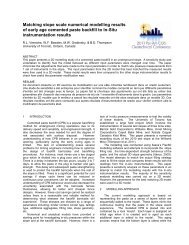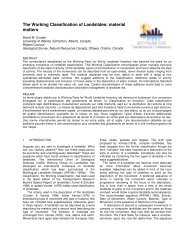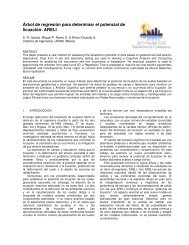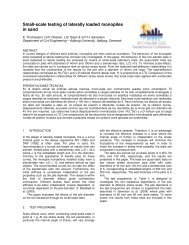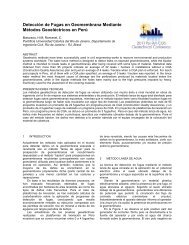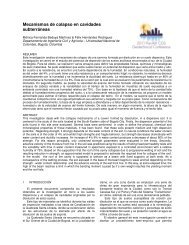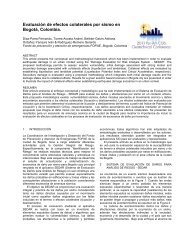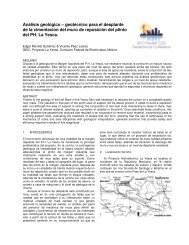Deformations of a highway embankment on degraded permafrost
Deformations of a highway embankment on degraded permafrost
Deformations of a highway embankment on degraded permafrost
Create successful ePaper yourself
Turn your PDF publications into a flip-book with our unique Google optimized e-Paper software.
Depth (m)Depth (m)Depth (m)Depth (m)Stable Secti<strong>on</strong>, Mid SlopeTemperature (˚C)-6 -4 -2 0 2 4 6 8 10 12 14 16 18 20-10Min AveMax12342008-092009-105Stable Secti<strong>on</strong>, ToeTemperature (˚C)-6 -4 -2 0 2 4 6 8 10 12 14 16 18 200AveMaxMin12342008-092009-10Figure 10. Annual temperature envelopes betweenNovember 2008 and October 2010 for the stablesecti<strong>on</strong> at the a) mid-slope; b) toeFigures 9 and 10 show average temperature pr<str<strong>on</strong>g>of</str<strong>on</strong>g>ilesover two years at the four instrumented locati<strong>on</strong>s, that isat the toes and mid-slopes <str<strong>on</strong>g>of</str<strong>on</strong>g> the two test secti<strong>on</strong>s. Nosub-zero temperatures were observed during 2008-09 and2009-10. The average temperatures at all four locati<strong>on</strong>sdecrease with increasing depth. This indicates a net heatflux into the foundati<strong>on</strong> soils. It also supports theobservati<strong>on</strong>s in an earlier secti<strong>on</strong> that initially frozen soilhas thawed during the lifetime <str<strong>on</strong>g>of</str<strong>on</strong>g> the soil - there has beengeneral warming <str<strong>on</strong>g>of</str<strong>on</strong>g> the <str<strong>on</strong>g>embankment</str<strong>on</strong>g>s and theirfoundati<strong>on</strong>s.Figure 11 shows the m<strong>on</strong>thly temperature pr<str<strong>on</strong>g>of</str<strong>on</strong>g>iles for<strong>on</strong>e cycle <str<strong>on</strong>g>of</str<strong>on</strong>g> cooling and heating between November 2009and October 2010. The two graphs in Figure 11 c<strong>on</strong>taindata from instrument clusters at a) mid-slope and b) toefor the unstable secti<strong>on</strong>. (For reas<strong>on</strong>s <str<strong>on</strong>g>of</str<strong>on</strong>g> space andclarity, we are not including observati<strong>on</strong>s from 2008-2009and 2010-2011.)With increasing depths, seas<strong>on</strong>al differences intemperature become less. The depth <str<strong>on</strong>g>of</str<strong>on</strong>g> zero annualtemperature amplitude is the depth at which the seas<strong>on</strong>alvariati<strong>on</strong>s <str<strong>on</strong>g>of</str<strong>on</strong>g> temperatures are essentially zero(Andersland and Ladanyi, 2004). Figures 11a and 11bshow that the depth <str<strong>on</strong>g>of</str<strong>on</strong>g> zero annual amplitude at thea)b)unstable secti<strong>on</strong> is about 8 – 9m below the original ground012345678910Unstable Secti<strong>on</strong>, Mid Slope, Nov 09-Oct 10Temperature (˚C)-6 -4 -2 0 2 4 6 8 10 12 14 16 18 20-10a)123402-Nov-09 15-Nov-09505-Dec-09 21-Jan-10619-Feb-10 15-Mar-10714-Apr-10 15-May-10815-Jun-10 16-Jul-10916-Aug-10 13-Sep-101025-Sep-10 04-Oct-1011Unstable Secti<strong>on</strong>, Toe, Nov 09-Oct 10Temperature (˚C)-6 -4 -2 0 2 4 6 8 10 12 14 16 18 2002-Nov-0905-Dec-0919-Feb-1014-Apr-1015-Jun-1016-Aug-1025-Sep-1015-Nov-0921-Jan-1015-Mar-1015-May-1016-Jul-1013-Sep-1004-Oct-10Figure 11. M<strong>on</strong>thly temperature pr<str<strong>on</strong>g>of</str<strong>on</strong>g>iles betweenNovember 2009 and October 2010 for the unstablesecti<strong>on</strong> at the a) mid-slope; b) toelevel.The respective temperatures pr<str<strong>on</strong>g>of</str<strong>on</strong>g>iles for the mid-slopeand toe c<strong>on</strong>verge at about the same depth, although thereis approximately a 1.6°C difference between the twovalues. The soil underneath the <str<strong>on</strong>g>embankment</str<strong>on</strong>g> is colderthan soil at the same depth underneath the toe. It isbelieved that this can be explained by the previouspresence and thawing <str<strong>on</strong>g>of</str<strong>on</strong>g> a frost bulb underneath the<str<strong>on</strong>g>embankment</str<strong>on</strong>g> or alternatively by differences in thermalc<strong>on</strong>ductivity between gravel in the <str<strong>on</strong>g>embankment</str<strong>on</strong>g> and clayin the foundati<strong>on</strong> soils. This observati<strong>on</strong> could have beenverified if thermistor strings had been installed under thecentre <str<strong>on</strong>g>of</str<strong>on</strong>g> the <str<strong>on</strong>g>embankment</str<strong>on</strong>g>. Perhaps unfortunately, safety,snow clearing, and grading made this impossible. Coolertemperatures beneath the <str<strong>on</strong>g>embankment</str<strong>on</strong>g> may also be dueto an insulating cover <str<strong>on</strong>g>of</str<strong>on</strong>g> snow beneath the toe, combinedwith the effects <str<strong>on</strong>g>of</str<strong>on</strong>g> show clearing <strong>on</strong> the roadway.4 SUMMARYb)



